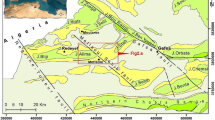Abstract
Irrigation-induced landslide is a recurring problem in the Heifangtai loess platform of northwest China. The landslide sites are characterized by a concave topography. Numerical modeling indicates that the groundwater table at the past-landslide site rises more quickly than the other natural platform borders under irrigation conditions. This is consistent with the field observations that seepage of the groundwater appeared in the hollow is higher than that of lateral slopes. In order to investigate the response of soil behavior due to rise in groundwater table, stress-path tests were performed on undisturbed specimens. It has been observed that the increase in pore water pressure in loess can trigger soil liquefaction and eventually results in landslide. Hence, the concave past-landslide site is much more prone to landsliding, which contributed to the landslide recurrence.












Similar content being viewed by others
References
Anderson SA, Sitar N (1995) Analysis of rainfall-induced debris flows. ASCE J Geotech Eng 121:544–552
Been K, Jefferies MG, Hachey J (1991) The critical state of sands. Geotechnique 41:365–381
Berne A, Uijlenhoet R, Troch PA (2005) Similarity analysis of subsurface flow response of hillslopes with complex geometry. Water Resour Res 41:W09410. doi:10.1029/2004WR003629
Brand EW (1981) Some thoughts on rain-induced slope failures. In: Proceedings of the 10th international conference on soil mechanics and foundation engineering balkema, vol 3. Rotterdam, pp 377–384
Buma J, Dehn M (1998) A method for predicting the impact of climate change on slope stability. Environ Geol 35:190–196
Canuti P, Focardi P, Garzonio CA (1985) Correlation between rainfall and landslides. Bull Eng Geol Environ 32(1):49–54
Castro G (1975) Liquefaction and cyclic mobility of saturated sands. ASCE Geotech Eng Div 101:551–569
Coelho-Netto AL, Avelar AS, Fernandes MC, Lacerd WA (2007) Landslide susceptibility in a mountainous geoecosystem, Tijuca Massif, Rio de Janeiro: the role of morphometric subdivision of the terrain. Geomorphology 87:120–131
Derbyshire E, Meng XM, Dijkstra TA (eds) (2000) Landslides in the thick loess terrain of north-west China. Wiley, Chichester, UK, pp 1–288
Eckersley JD (1990) Instrumented laboratory flow slides. Geotechnique 40:489–502
Fernandes NF, Guimaraes RF, Gomes RAT, Vieira BC, Montgomery DR, Greenberg HM (2004) Topographic controls of landslides in Rio de Janeiro: field evidence and modeling. Catena 55:163–181
Finlay PJ, Fell R, Maguire PK (1997) The relationship between the probability of landslide occurrence and rainfall. Can Geotech J 34:811–824
Fredlund DG, Xing A (1994) Equations for the soil–water characteristic curve. Can Geotech J 31:521–532
Gabeta EG, Mudd SM (2006) The mobilization of debris flows from shallow landslides. Geomorphology 74:207–218
Guzzetti F, Galli M, Reichenbach P, Ardizzone F, Cardinali M (2006) Landslide hazard assessment in the Collazzone area, Umbria, Central Italy. Nat Hazards Earth Syst Sci 6:115–131
Hennrich K, Crozier MJ (2004) A hillslope hydrology approach for catchment-scale slope stability analysis. Earth Surf Proc Land 29:599–610
Hilberts A, Van Loon EE, Troch PA, Paniconi C (2004) The hillslope-storage Boussinesq model for non-constant bedrock slope. J Hydrol 291:160–173
Lade PV (1992) Static instability and liquefaction of loose fine sandy slopes. J Geotech Eng 118:51–71
Montgomery DR, Dietrich WE (1994) A physically based model for the topographic control on shallow landsliding. Water Resour Res 30:1153–1171
Montgomery DR, Schmidt KM, Greenberg HM, Dietrich WE (2000) Forest clearing and regional landsliding. Geology 28:11–314
Riemer MF (1992) The effects of testing conditions on the constitutive behavior of loose saturated sands under monotonic loading. PhD thesis, University of California, Berkeley
Sasitharan S, Robertson PK, Sego DC, Morgenstern NR (1993) Collapse behavior of sand. Can Geotech J 30:569–577
Talebi A, Uijlenhoet R, Troch PA (2008) A low-dimensional physically based model of hydrologic control of shallow landsliding on complex hillslopes. Earth Surf Proc Land 33:1964–1976
Tsuboyama Y, Sidle RC, Noguchi S, Murakami S, Shimizu T (2000) A zero-order basin—its contribution to catchment hydrology and internal hydrological processes. Hydrol Process 14:387–401
Tu XB, Dai FC, Kwong AKL, Tham LG, Xu L (2009) Causes of recurring landslides in loess Plateau, Shaanxi Province, China. HKIE Transaction 17:36–44
Wu WJ, Wang NQ (2006) Landslide Hazards in Lanzhou. Lanzhou University Press, Lanzhou, pp.1–287. (In Chinese)
Xu L (2010) Mechanism of the loess landslide induced by agricultural irrigation. PhD Thesis. Institute of Geology and Geophysics, China Academy of Sciences
Xu L, Dai FC, Kwong AKL, Min H (2008) Types and characteristics of loess landslides at Heifangtai loess plateau, China. J Mt Sci 26:364–371 (In Chinese with English abstract)
Xu L, Dai FC, Tham LG, Tu XB, Jin YL (2011a) Landslides in the transitional slopes between a loess platform and river terrace, Northwest China. Environ Eng Geosci XVII:267–279
Xu L, Dai FC, Tham LG, Tu XB, Min H, Zhou YF, Wu CX, Xu K (2011b) Field testing of irrigation effects on the stability of a cliff edge in loess, North-West China. Eng Geol 120:10–17
Xu L, Dai FC, Gong QM, Tham LG, Min H (2012) Irrigation-induced loess flow failure in Heifangtai Platform, North-West China. Environ Earth Sci 66:1707–1713
Yamamuro JA, Lade PV (1997) Static liquefaction of very loose sands. Can Geotech J 34:905–917
Zhang DX, Wang GH, Lou C, Chen J, Zhou Y (2009) A rapid loess flow slide triggered by irrigation in China. Landslides 6:55–60
Acknowledgments
The financial support by National Nature Science Foundation of China (NSFC) (No: 51109199) is acknowledged.
Author information
Authors and Affiliations
Corresponding author
Rights and permissions
About this article
Cite this article
Xu, L., Qiao, X., Wu, C. et al. Causes of landslide recurrence in a loess platform with respect to hydrological processes. Nat Hazards 64, 1657–1670 (2012). https://doi.org/10.1007/s11069-012-0326-y
Received:
Accepted:
Published:
Issue Date:
DOI: https://doi.org/10.1007/s11069-012-0326-y




